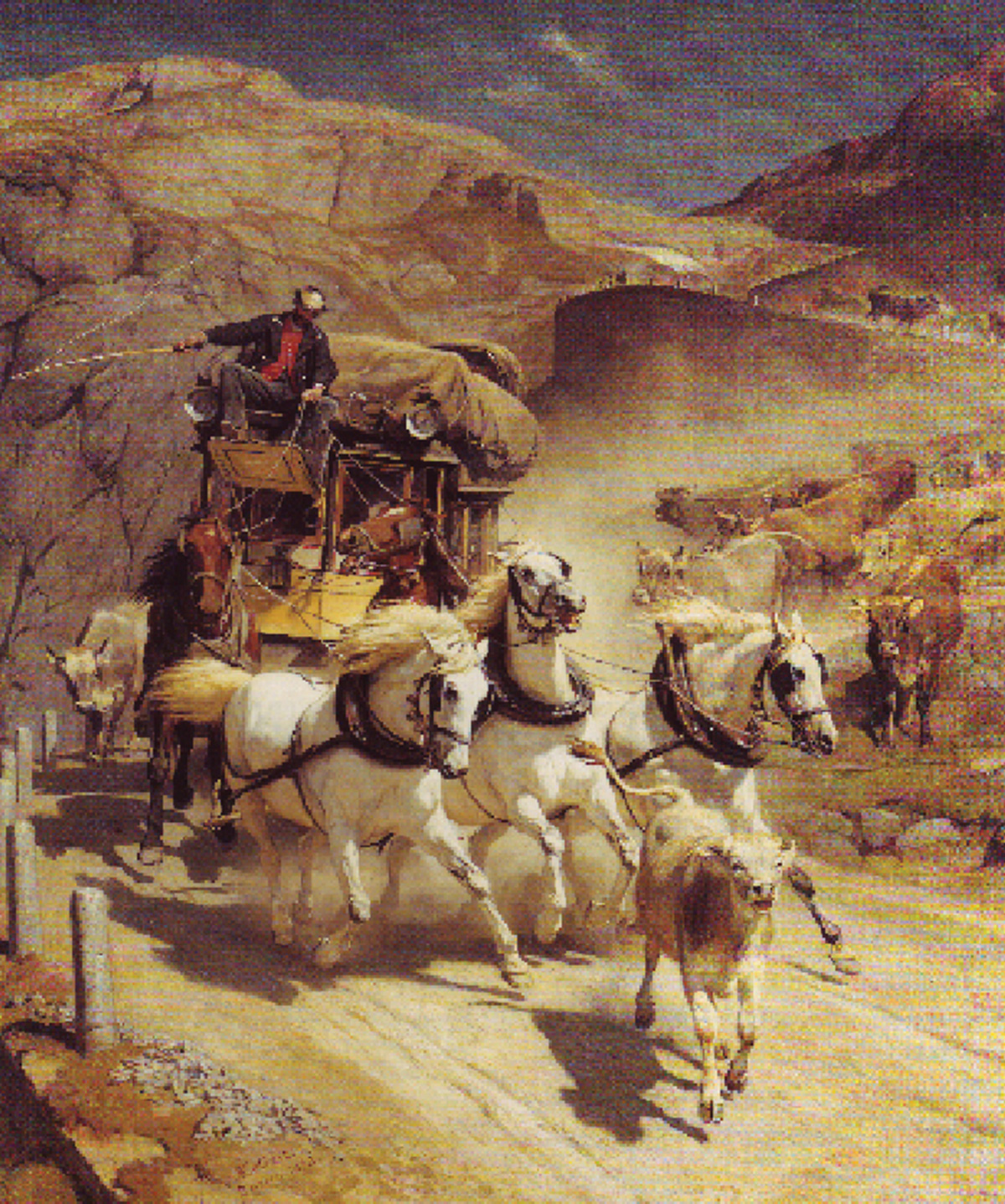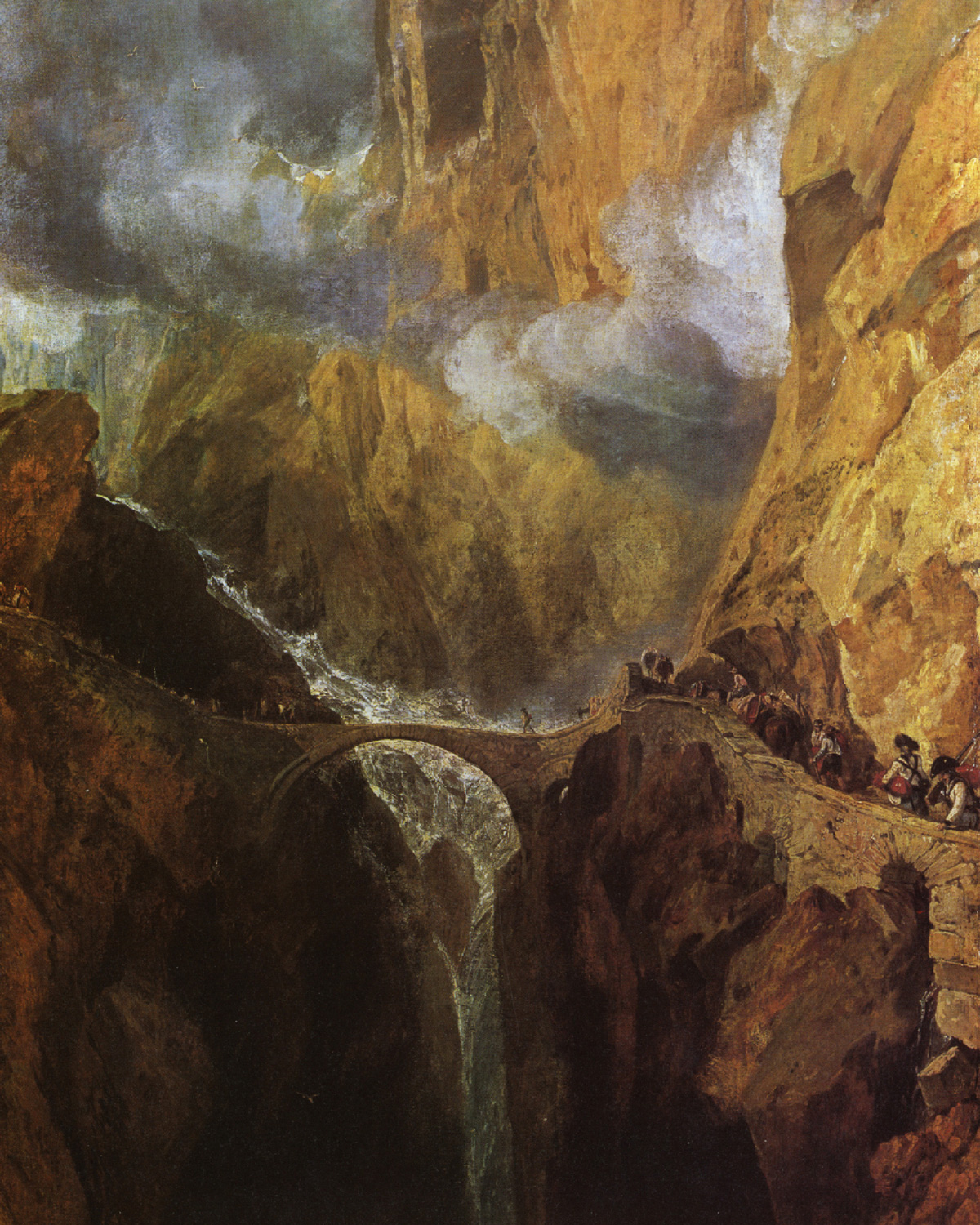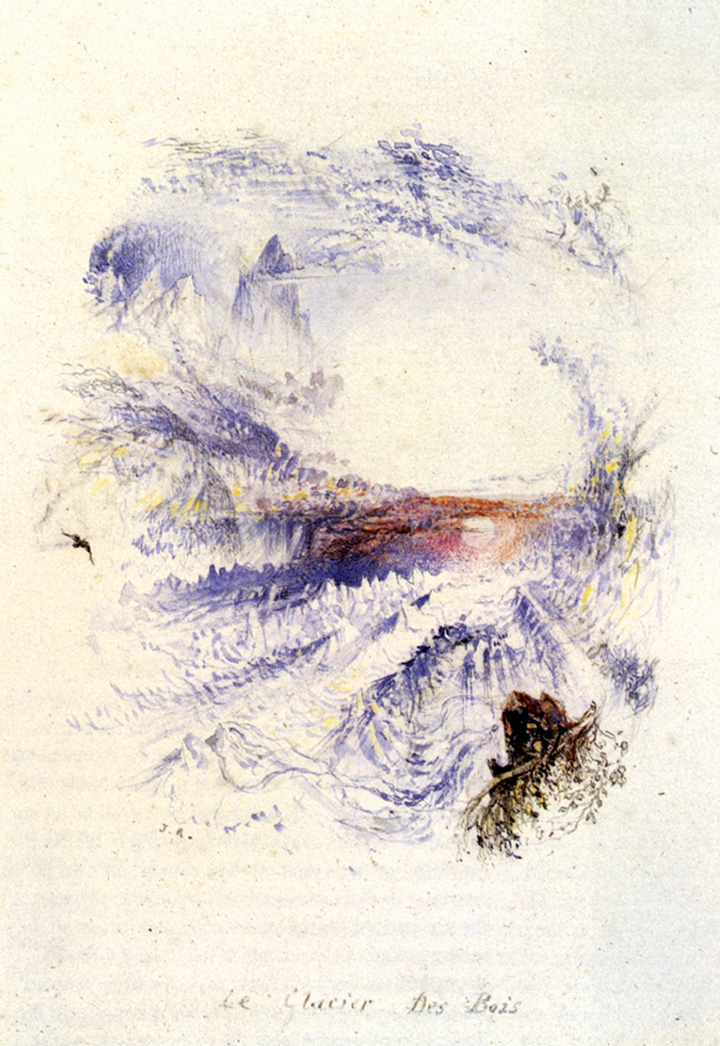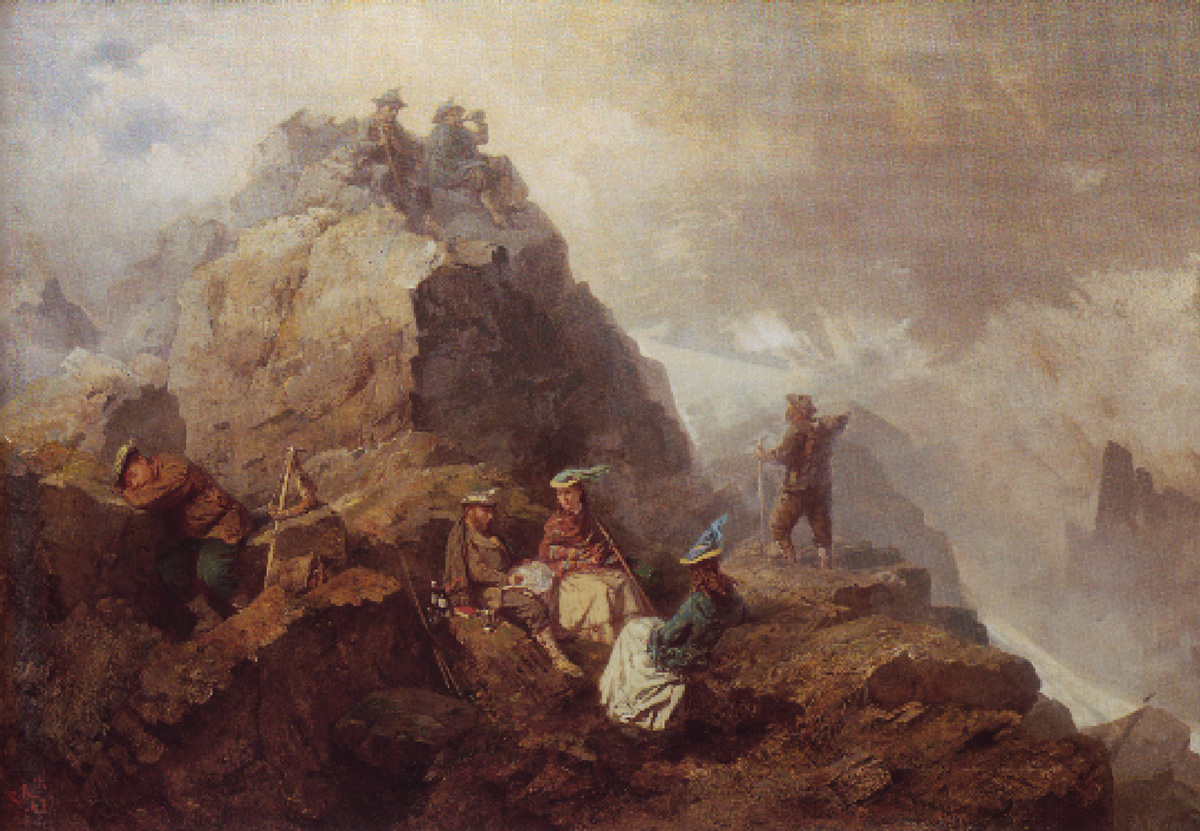O Altitudo!: An Interview with Robert Macfarlane
Peak aesthetics
Brian Dillon and Robert Macfarlane
On 2 August 1802, Samuel Taylor Coleridge—who was already in the habit of scaling mountains and, instead of descending by the safest available route, making his way back down by the first, often perilous, pathway that presented itself—ascended Scafell, England’s second-highest mountain, in the Lake District. This time, on the way down, he got stuck, and found himself facing a twelve-foot drop to a ledge so narrow “that if I dropt down upon it I must of necessity have fallen backwards and of course killed myself.” Coleridge survived, and in the account he later gave of the escapade, rehearsed some key terms from a mountainous aesthetic that has flourished for at least two centuries: the experience, he said, was one of prophecy, trance, delight, shame, pain, dreaming, madness, and laughter. Robert Macfarlane is a fellow of Emmanuel College, Cambridge, where he teaches English literature. He has recently published Original Copy: Plagiarism and Originality in Nineteenth-Century Literature (2007) and The Wild Places (2007), a tour and study of the wildernesses of Britain and Ireland. Macfarlane’s first book, Mountains of the Mind: A History of a Fascination (2003), essays a historical and personal description of the mixed aesthetic, moral, and scientific modes of mountain appreciation: from the crossing of the Simplon Pass by Thomas Burnet in 1672 to the disastrous attempt on Everest by George Mallory in 1924. Brian Dillon spoke to Macfarlane in Cambridge in May 2007.
Cabinet: The cultural understanding of mountains seems so bound up with the aesthetics of the sublime and the advent of Romanticism that it is hard to understand exactly what mountains meant before the eighteenth century. Were they simply seen as blanks, deserts, wild places?
Robert Macfarlane: It would be wrong to propose that there’s no refined mountain perception prior to Romanticism. You only need to look at someone like Leonardo da Vinci. He’s making extraordinary sketches of mountain phenomena in the Italian Alps: they’re beautiful, and attentive both to meteorology and geology. In so many ways—as he always does—da Vinci anticipates what’s to come by several centuries. There’s also a biblical tradition of revelation at height: Moses, obviously, on Sinai, or on Mount Pisgah, looking down into the promised land. So there are visionary traditions that precede the late eighteenth century. Petrarch claims to have climbed Mount Ventoux in April 1336; doubts have been voiced about whether he actually made the ascent, but the falsifiability of the account doesn’t really matter, because he gives us one of the first expedition journals (the book of Exodus would be another of these), and one of the first mountain descriptions in which mountain and text, or mountain and representation, become blurred almost to the point of interchangeability. So, in one sense, you can construct a tradition of the visionary and the beautiful for mountains which precedes Romanticism, going as far back as you want to go. But on the other hand, it’s quite possible to argue that mountains existed as little more than wallpaper, by and large, through the Medieval and Early Modern periods. They are often inattentively represented by artists: they become warped and distorted into strange fungal shapes. Cartographically, there’s no precision in their representation, just these generic molehill symbols: contour is not added until the seventeenth century. Everything speaks of an indifference. This is because there’s no impulse to pay attention to the mountain form. Functionally, mountains are objectionable; agriculturally, they’re useless; and in terms of pilgrimage and trade, they’re obstructive.

Apart from the obvious anxiety that one might feel up a mountain—fear of falling off it—what do you think is the precise nature of the common aesthetic distaste for mountains that is later appropriated for the pain-pleasure continuum of the sublime?
There’s a lovely moment from the journals of the philosopher Bishop George Berkeley where he crosses the Alps, and he records afterwards that he was “put out of humor by the most horrible precipices.” He has an automatic reaction of disgruntlement or distaste, a sense that the irregularity of the mountainscape was somehow disturbing to him. Physicality has really upset Berkeley; he can’t think these things out of existence, and philosophical idealism won’t work in a mountain context. Either that, or he’s just tired and cold and has maybe got a touch of frostnip.
I know that feeling myself—anyone who has been in the mountains will have had a version of that fatigue, discomfort, sensory excess. Mountains disturb the spirit level of the perceiver’s mind, as well as the systems of the body, and so again and again we get anecdotes from those who’ve crossed the Alps in the seventeenth and eighteenth centuries and been somehow perturbed. It may be apocryphal, but there’s evidence that until well into the eighteenth century, wealthy travelers who had to cross the Alps would actually pay to be blindfolded and led over the highest passes. That might be due to vertigo, or it might be a high aesthetic sensibility at work, but either way it’s remarkable to compare that with the viewpoint culture of present-day mountain worship.
There seems to be a kind of aesthetic hierarchy in the eighteenth century when it comes to mountains, with the sublime at its summit and the grotesque, the picturesque, and the beautiful making up the lower slopes. How is this linked to the competitive, masculine culture that develops among mountaineers?
First, I think the other category to add is the wonderful. Descartes, for example, sees wonder as prompting an urge to explain or to give an account. Confronted with a wonder, you are at first astonished, and then you wish to understand how you came to be astonished: wonder, for Descartes, is the root of science. The eighteenth-century sublime, on the other hand, is quite a vulgar form of affect in many of its manifestations: it obliterates all impulses except its own. My book is really a description of my own move away from a kind of crude sublime-seeking to a slightly more ecologically-minded wonder. I’ve become increasingly interested in wonder as a response to landscape. It seems more accountable, really: the sublime by its very nature is deeply unaccountable and supra-ethical.
The rage for the sublime, begun in the mid-eighteenth century, is what starts off the macho aspect to mountain culture, which had its most appalling expression in Nazi Germany, when the sublime becomes muscularized and masculinized, and nationalized in the worst sense of that word.
The novelist John Fowles talks, pejoratively, about landscape as “a gymnasium for the sensibilities,” and obviously this idea has an eighteenth-century origin. We have, for instance, Rousseau saying that he must giddy himself, must find himself beside steep precipices: there is a desire to test and prove the self already at work. Worship of the sublime is brilliantly parodied in Samuel Butler’s novel The Way of All Flesh, where the Pontifex family goes on Grand Tours to Mont Blanc and conduct a preordained pilgrimage of ecstasy. Pontifex is already gushing in Byronic terms about Mont Blanc before he’s even seen it. It’s a good example of how the sublime can stop you seeing, oddly: it begins as a heightened response and ends as an ossified response that interposes itself almost totally between person and place.
One striking element in your account of the representation of mountains in the nineteenth century is the almost anamorphic effect it has on the perception of landscape: both in terms of painting and in popular spectacles such as the panorama. Is it true to say that exploration of mountains does something to traditional notions of perspective?
In terms of landscape painting, we might start with the three-tiered landscapes of Claude Lorrain, which divide space harmonically into foreground, landscape, and sky. Then, by contrast, there are J. M. W. Turner’s St. Gotthard Pass images, which are basically Claudean images that have been whipped through ninety degrees, so they’re still divided into thirds but are now arranged on a vertical axis, such that we view rock/space/rock. Around the time of Turner, an appetite emerges for this vertiginous viewing experience—which obviously Turner is partly inducing—whereby the viewer is pulled in and disoriented.

Then there are the vortical forms that John Ruskin uses when he tries to represent the experience of looking at a glacier (even though a glacier is technically a static entity, at least if you’re watching it only for a minute or two). Ruskin was trying to capture the dynamic nature of the glacial substance, which is neither fluid nor solid, but somewhere in between.
And then there’s the rotunda and the panorama, these strange and highly popular new viewing methods, such as the Leicester Square Rotunda. The rotunda gives you a godlike view, a 360-degree panorama—a viewpoint previously reserved for birds and divinities.
What is extraordinary about being on a mountain summit (at least in good weather) is that you can see different seasons, different countries, and sometimes even the curvature of the earth. You view hundreds of miles in all directions: you occupy a panoptical point, really. This is both an egotistical and a quashing experience: you see backwards in time, outwards in space, and are both uplifted and diminished by that experience. For whatever reason, that mixture of self-celebration and self-obliteration, which is a version of the pain-pleasure mixture of the sublime, is incredibly compelling.

How does the burgeoning geological understanding of the origin and history of mountains feed into their cultural appreciation?
Geology is a relatively young science. It was born in the late eighteenth and early nineteenth centuries, and right from its inception, it had a big conceptual battle to fight with theology. There was a pre-existing Young Earth orthodoxy; at its most extreme, this is epitomized in the dating of the creation of the earth to 4004 BCE by Archbishop James Usher, which crops up in the shoulder notes of bibles into the nineteenth century. However, as became increasingly clear to geologically minded scientists, the earth could not possibly be only a few millennia old. Such a dating did not allow nearly enough time for the earth to have achieved the complex and eroded form that it was palpably seen to have achieved.
One solution to this problem was proposed by Thomas Burnet in his Sacred Theory of the Earth, published in 1681. Burnet proposed that mountains were not created as we now see them. Rather, they were the consequence of a punitive flood visited upon the globe by God to reprimand sinful peoples; mountains are the debris left by the recession of the flood. Now, such a proposition doesn’t of course age the earth, but it does introduce a contingency to the structure of the landscape itself.
The battle is then moved on by Georges Buffon, who takes the seven days of creation as metaphors for periods of time of indefinite length, so that suddenly—brilliantly—he’s busted open time, such that it can unfold almost limitlessly backwards. Subsequently, there are people like James Hutton, the Scottish geologist working in the late-eighteenth century, and Charles Lyell, whose Principles of Geology comes out in 1833 and is read avidly by Charles Darwin. Lyell and Hutton assert a uniformitarian view that the earth hasn’t been created by any global-level catastrophe. What we see is in fact the consequence of erosion, weathering, river-cutting—all the habits of landscape that we see at work around us, but taking place over, potentially, billions of years.
Now, this deepening of time drastically changed—and changes—the experience of being in the mountains. You’re no longer inhabiting a recently created, static landscape which has local dynamisms; you’re inhabiting an inconceivably ancient landscape which is itself the present avatar of ghostly landscapes that once were. If you have a certain inductive quality of vision—such as that which Lyell’s work taught hundreds of thousands of people to have—you can see those ghost landscapes. So people like Ruskin and Darwin come to stand on mountaintops and are able to observe, or imagine they are observing, not what is there but what was there and what will be there. This extraordinary move away from the present tense and into these spans of time to come and time gone brings with it a kind of temporal vertigo that’s recognizable to people in many forms, but particularly to mountaineers.
Ruskin is a good example of a writer who wants his prose style to follow the contours of the mountains he’s describing: to scale their heights and plumb their depths. And yet, like many of the classic post-Romantic accounts of mountains, his is punctuated by assertions of the essential unrepresentability of the landscape. Why is that trope so common?
Ruskin’s writing has its peaks and its troughs and its scree slopes and its little landslips: it’s in so many ways an embodiment or an enacting of the mountainscape in prose form. He’ll often begin to describe a mountain scene in the foreground, and then he’ll move us upwards and there will be these sudden falls or lurches, where suddenly he’ll drop you a million years back in time, before yanking you back up to the present again. There is a wonderful moment in “Of Mountain Beauty,” when he talks about how the tracks of a glacier are as fresh to him as the prints in mud of a horse that has passed by only the previous day.
The trope of unrepresentability is probably the commonest of all in mountain literature and art: the throwing up of the hands, the confession of the inadequacy of representation to catch the phenomena of the mountain world. I remember reading the journal of an Edinburgh bishop from the 1760s who’d gone on a mini-Caledonian tour. He writes: “I looked north and saw rank on rank of unspeakably beautiful…” He crosses out “unspeakably”—he’s obviously unhappy with it—and writes instead “mountains so beautiful I could not describe them.” Then he crosses that out, and we get four synonyms for “indescribable,” the first three crossed out. What’s exciting about Ruskin is that instead of acquiescing to indescribability, he tries to enact it, to let his art or prose take the forms of their subjects. In his drawing of the Glacier du Bois, near Chamonix, for example, the whole image is vortical; everything is being tugged by some centripetal force which has no apparent center but which is clearly at work. It’s hard to say what that force is, but it has something to do with time, a kind of deep time that is at work in that viewing moment. The glacier looks like a river in flood, in spate; the sun looks to have been absorbed by it, and there’s an inexplicably detached tree bole and root in the foreground. Even his curving signature seems to be vulnerable to the vortex.
George Mallory, who died on Everest in 1924, and whose body was not discovered until 1999, seems to have been especially susceptible to the metaphoric or metonymic displacement of rock into idea.
Mallory was an intensely idealistic, idealizing, and idealized figure; he sees everything literarily, in a Romantic, Keatsian fashion. He can’t let the mountains simply be themselves; they always have to be metaphorized or transformed in some way. Even right up to the end, near his death, when confronted by Everest for the third time—and nothing could be more implacably, utterly itself than Everest—there’s always a “like,” always some transformation going on in his apprehension of the mountain.
You could say that metaphor kills Mallory, that he was murdered by figure. For he is drawn to Everest not out of any fondness for the thing itself, but because he had been taught to love the idea of Everest, and all that it, in its superlativeness, represented. Mountains are—like all inanimate nature—entirely indifferent to their pictures and their picturers. For Mallory, however, his relationship with Everest was one of love affair: the language he uses to describe his desire for Everest ranges between the erotic (he once likens the clouds clearing in front of the mountain to a striptease), the amatory (he conceives of his relationships with Everest and with his wife, Ruth, as a love triangle), and the obsessional. There are heartbreaking letters that he writes back to Ruth: as he nears Everest, the mountain looms larger in the letters and Ruth recedes. Of course, the mountain has no knowledge of Mallory and goes about its processes according to unemotional laws, but he cannot resist trying to anthropomorphize or sentimentalize his relationship with Everest, to make humanly meaningful the experience of being on the mountain.

The metaphorization continued after Mallory’s death—which Arthur Hinks, then Secretary of the Mount Everest Committee, described at the time as being mitigated by “the knowledge that they died somewhere higher than any man had ever been before”—and the deaths of countless mountaineers before and since. Do you think the symbolism of glorious death at altitude survives in contemporary mountain culture?
I now find the idea of the high-altitude death as glorious most odd. But I found it very powerful indeed, very compelling, about ten years ago. Then, I was rather smitten by the masculine, self-testing, mid-nineteenth-century visions of mountaineering. Marriage and parenthood changed all that. Speaking in terms of general culture, however, it seems that the vision of heroic death in extremis is even more compelling now—partly because it’s less available to us. We demonstrate a fierce nostalgia for the golden age of exploration: partly out of a longing for terra incognita, for that which is unexplored, and partly because many people are attracted to the idea of a glorious, paramilitary death.
Fortunately, there’s also a rather more benign, ecologically minded approach to wild landscape emerging now, born partly out of anxiety over climate change and wider environmental degradation, partly out of an exhaustion or intemperance with the militarized, masculinized approach to mountain-climbing.
Robert Macfarlane is a fellow of Emmanuel College, University of Cambridge, where he teaches English literature. He has recently published Original Copy: Plagiarism and Originality in Nineteenth-Century Literature (Oxford University Press, 2007) and The Wild Places (Granta, 2007).
Brian Dillon is UK editor of Cabinet, and writes regularly for Frieze, Modern Painters, and Art Review. His memoir, In the Dark Room (Penguin, 2006), won the inaugural Irish Book Awards non-fiction prize. He is working on Tormented Hope: Nine Hypochondriac Lives, to be published in 2008.
Spotted an error? Email us at corrections at cabinetmagazine dot org.
If you’ve enjoyed the free articles that we offer on our site, please consider subscribing to our nonprofit magazine. You get twelve online issues and unlimited access to all our archives.